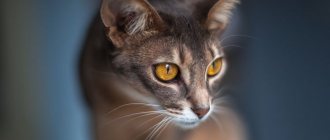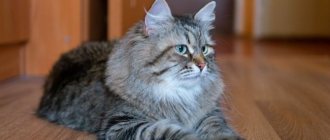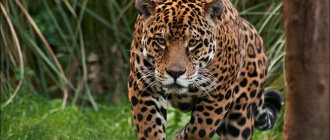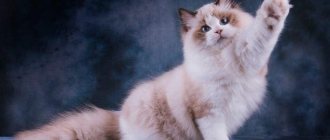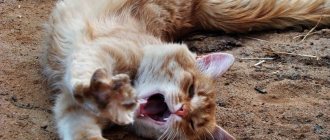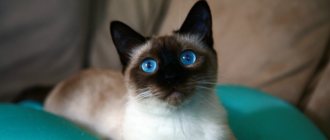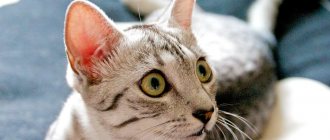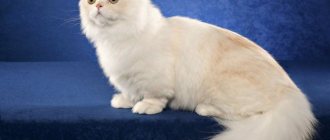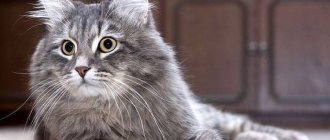History of Pied Pipers
The domestication of cats began in Ancient Egypt. People, seeing that these animals preyed on rodents eating food supplies, began to domesticate them. At that time, cats were sacred animals and they were fined for killing them. If a cat died in the house, people shaved their eyebrows as a sign of mourning. A good rat-catcher cat cost as much as an ox.
In Russia, cats performed the duty of catching rats from peasants, in the territories of monasteries and even in the royal palace. Sovereign Peter the Great ordered the adoption of cats to protect barns. By decree of Tsarina Elizabeth Petrovna, thirty rat catchers from Kazan were brought to the Winter Palace, since it was believed that the most skillful hunting cats lived there. During the reign of Empress Catherine the Great, cats were placed in the Hermitage to protect paintings and other valuables.
Ratcatcher cats help fight dangerous rodents
During the difficult years of the Great Patriotic War, cats saved Leningrad. When during the blockade all the animals in the city were eaten, houses and palaces were attacked by hordes of rodents. In 1943, 5 thousand cats arrived from Yaroslavl, and then another train of furry hunters from Siberia. Thanks to this, mice and rats quickly disappeared. To this day, fifty hunters, who are called “Hermitage cats,” live and work in the Hermitage in the status of Life Guards and museum employees.
How saber-toothed cats evolved
Scientists believe that the first representatives of the breed settled in Africa, approximately 23,000,000 years ago. They did not have such huge fangs as their descendants, but there was a tendency for them to grow, and by the end of the Pleistocene the animals' fangs were extremely developed. This is evidenced by the findings of scientists.
The first skeletal samples of ancient animals were found in South America and then in Canada. But the most interesting of them is the jaw bone, which was caught by fishermen in the North Sea in 2000. Thanks to radiocarbon dating, the exact age of the find was determined - 28,000 years.
Samples found before were 300,000 years old. Therefore, the latest discovery became a real sensation. But in Europe they found the “youngest” part of the skeleton of saber-toothed cats, and in the singular. Therefore, scientists believe that, in all likelihood, cats lived in Eurasia for a very long time, but their population gradually declined.
Since the remains of saber-toothed cats were discovered on two continents, researchers hypothesized that the animals migrated from America to Eurasia overland, which was located on the site of the Bering Strait and connected both continents.
It is assumed that the saber-toothed cats that previously lived in Europe became extinct, and their place was taken by immigrants from America. This hypothesis is supported by a number of findings that indicate a genetic connection between Eurasian and American animals. But, in all likelihood, small populations lived in Europe. Therefore, only one fragment of the skeleton of a saber-toothed cat was found.
General features and habits
The rat catcher is not an independent breed, but a valuable animal skill. Representatives of some breeds have a particularly keen hunting instinct.
Felinologists identify the following external signs of cats capable of catching a rat:
- large body, powerful jaws, strong paws;
- special triangular (oriental) head shape;
- thick vibrissae, large ears with tassels.
It is impossible to determine a rat trap by its character - some hunters are affectionate, some are unfriendly. Sometimes a cat, trying to please its owner, catches rats and brings them to the person as a sign of love and affection.
Snub-nosed and fluffy
The original appearance of exotic cats has received popular recognition, although they were bred by accident by crossing different cats in an attempt to improve the Persian's coat. The resulting breed was rejected, but unexpectedly it gained widespread popularity.
The face attracts lovers, because of which exotics are rightfully considered one of the most unusual cat breeds. The cat's snub nose, wide-set round eyes and flattened muzzle leave no one indifferent.
The exotic coat is more similar to the British coat - it is shorter than that of the Persians and has a thick and soft undercoat.
Breeds of rat-catching cats
If you need to get a rat-catcher cat, you should choose among certain breeds. The natural inclinations of these purrs make them excellent hunters.
Russian blue
Representatives of this breed are not large in size; they have average dimensions and body weight. They are characterized by an instant reaction and are able to move silently for a long time. The victim is attacked quickly, accurately and gracefully. Russian blue cats are capable of catching large rats weighing about 0.5 kg. These animals do not get along well with cats of other breeds, but get along well with representatives of their own breed. They do not like displays of tenderness from people.
Russian blue cats are capable of catching large rats
We recommend this article:
Basic information and care for the Blue Russian cat
Kurilian Bobtail
The body weight of cats of this breed reaches 10 kg, and that of females – 6 kg. Distinctive features of these rat catchers:
- short tail - from 3 to 8 cm;
- long, strong hind legs.
Representatives of this breed jump well. They can completely destroy and destroy a mouse or rat hole. They are easy to train and easy to train. These fearless cats get along with other animals without problems and become excellent companions for people.
The Kurilian Bobtail gets along with other animals without any problems
We recommend this article:
All characteristics and features of keeping the Kuril Bobtail
Maine Coon
External differences between rat catchers of this breed:
- large body weighing up to 15 kg;
- straight, large ears with tassels;
- long, thick coat;
- wide chest;
- strong skeleton;
- powerful muscles;
- long, thick tail.
Maine Coons are strong, resilient and agile. They can live in harsh climates. They have the character of a predator, so they are not fans of signs of attention from people. Thanks to their size and physical strength, they easily cope with rats.
We recommend this article:
Description of the breed and features of keeping a Maine Coon cat
Siamese cat
The origins of the breed go back to the 13th century to the aborigines of the Kingdom of Siam. These are small, flexible, graceful animals with high intelligence and a love of freedom. Siamese are loyal to their owners, but do not tolerate authoritarianism in relations with people. Good reactions and the ability to be aggressive at the right time allow representatives of this breed to be excellent rat catchers.
We recommend this article:
Breed standard and characteristics of the Siamese cat
Abyssinian cat
The country of origin of this ancient breed is African Ethiopia. These rat catchers are willful, energetic and curious. They spend a lot of time hunting. They are characterized by medium body size, well-developed muscles and slender paws. Abyssins are resourceful and fearless.
Abyssinian cat Siamese cat Maine Coon
We recommend this article:
Characteristics of the ancient Abyssinian cat with Ethiopian roots
Siberian cat
The name of the breed arose because of the long, thick coat that its representatives possess. Siberian cats have a strong body weighing up to 9 kg and strong paws that provide a good grip. Since the hind legs are slightly longer than the front legs, Siberian cats run especially fast and jump well. These rat catchers have excellent reactions. They love to walk on their own and have an obstinate character.
In order for the animal to remain in good physical shape, it needs to constantly walk outside.
Siberian cats have an obstinate character
Cymric
A distinctive feature of the breed is its short tail, as if cut off. In this way she is similar to the Kurilian Bobtail. Cymrik is characterized by agility and tenacity. It is recommended to own cats of this breed for owners of private houses with outbuildings. Purrs need freedom of movement and lots of walks in the fresh air.
Cymrik is characterized by agility and tenacity
Manx cat
The fluffies of this breed are tailless. They have a friendly disposition and can even get along with a dog. The description of this breed is complemented by a good reaction and tenacious grip, which makes Manx cats excellent hunters.
British shorthair cat
The British combine excellent hunting instincts, visual attractiveness, friendliness and calmness. To please their owner, they bring captured rodents in exchange for a treat. The females of this breed are small, their weight does not exceed 4 kg, which is why they avoid large rats and hunt young individuals or mice. But the presence of such a pet on the site is an excellent prevention of rat infestation.
We recommend this article:
History of origin and characteristics of the British cat
European shorthair cat
These rat catchers fought against rodents back in Ancient Rome. Nowadays, Europeans are not considered thoroughbreds and are called domestics. This has not diminished their worldwide popularity as rat catchers. They are distinguished by their agility, gracefulness, and hunt with passion. They have short hair. The color is gray or spotted, marbled. Europeans are not against contact with people, they love to play, but they do not completely obey people.
European Shorthair British Shorthair Manx cat
Modern descendants of saber-toothed cats
Modern cats, even those living in the wild, have nothing to do with the saber-toothed beauties. Moreover, one cannot count among them the fluffy purrs who love to sleep on the sofa or near the radiator. It has been proven that saber-toothed cats have no direct descendants.
However, researchers believe that the clouded leopard is the closest predator to saber-toothed tigers. It is enough to look at its fangs to understand that it may be an indirect descendant of saber-toothed predators, which appeared in the process of evolution.
Despite the fact that saber-toothed cats have long been extinct, they are still popular and become heroes of films and cartoons. So Smilodon appeared in the fifth episode of the film “Walking with Monsters”, and in the fourth episode the creators of the series talked about another saber-toothed cat - Dinofelis, which resembles a modern jaguar.
Children are also familiar with wild cats, or rather Smilodon. The saber-tooth character Diego has become one of the favorite characters in the cartoon “Madagascar”. Ancient predators are also found in some games, such as Zoo Tycoon Extinct Animals. So saber-toothed cats have actually become a part of our lives.
How to raise and care for hunters
Even if a kitten of the right breed has been chosen, this does not guarantee that it will become a rat catcher. The determining factor here is the behavior of his mother cat. If she hunts rodents, then the kitten will acquire the necessary skills from a very early age, and this is difficult to instill artificially.
You cannot separate a kitten from its mother too early, because only she can teach the baby to hunt. It is better to take an already strong fluffy at the age of 4-5 months.
When raising a future rat catcher, you need to adhere to the following rules:
- They will encourage the pet's love of hunting and praise it for catching a rodent.
- Don't starve your cat by trying to encourage him to hunt. A hungry animal will either run away or eat from neighbors or in a garbage dump.
- Monitor the physical shape and body weight of the purr, do not overfeed. It is recommended to feed 5-6 times a day, but in small portions.
- Get the required vaccinations, especially against rabies. This is important because during a fight with a rat, the rodent may bite the cat.
If your cat is scratched or bitten during the accident, you should contact a veterinarian to avoid developing rabies.
The animal must be vaccinated against rabies
The most famous types of saber-toothed cats
Previously, saber-toothed cats were divided into three species, but recently they settled on only two of them: Smilodontini and Machairodontini.
Smilodon
or saber-toothed tigers lived in America and were very large representatives of the subfamily. Their weight ranged from 150 to 400 kg, that is, more than many modern tigers. But their tail did not look like a tiger's. It was short and more like the tail of a lynx. The main feature of Smilodon is its mouth with fangs up to 30 cm long.
Smilodon are divided into several groups. The largest of them is the Smilodon destroyer (populator), which hunted in South America and weighed on average 400 kg. The most studied is Smilodontini fatalis, whose weight reached only 200 kg. The ancestor of Smilodon is considered to be Smilodontini gracilis, which lived in the western part of America.
Mahayrods
They were small in stature and weight and lived in Africa, Eurasia and America. They resemble modern wild cats, but many of them were significantly ahead of them in height and weight, as they reached one and a half meters and weighed more than 200 kg.
How to choose the right kitten
When choosing a future rat catcher, you need to take into account the following characteristics of the animal:
- Body type. A furry hunter must be able to take on a large rodent, so he must be big himself. Requirements for a rat catcher: large, powerful body, developed muscles, powerful, wide bones, strong paws, general stockiness. It is important that the size of a cat is determined by the state of its muscles, and not by the amount of fat.
- Floor. Among males, rat catchers are a rare occurrence. Cats are usually good hunters. This can be explained by the need for females to feed their offspring, teach kittens, and protect them.
- Game method. If you need a cat as a rat catcher, you should check how it behaves with a furry toy mouse. Potential hunters rush at the toy and grab it with their teeth, gnawing it. Ordinary fluffies just play with the mouse with their paws.
- Head shape. To make sure that the cat’s skull is triangular, you need to carefully feel it by pressing the cat’s ears.
- External signs. Ratcatchers often have large, tufted ears. It is better to choose a striped or tri-color color. In this case, it will be easier for the hunter to disguise himself.
It is almost impossible to raise a rat catcher on your own. Therefore, when choosing a kitten, you should pay attention to the list of breeds that have special hunting instincts.
Recommended Posts
The main stages and duration of pregnancy in cats
Character and appearance of the Neva masquerade cat
Caring for a Scottish Fold cat during pregnancy
Overview of the Celtic or European Shorthair Cat Breed
Description of 9 cat breeds with big ears
Features of care and feeding of the Scottish fold cat
Why did saber-toothed cats become extinct?
It is believed that saber-toothed cats became extinct during the Ice Age, following mammoths and mastodons. After all, they hunted only large game, sinking their fang teeth into the prey.
When the giant mammals died, cats lost their main food source. They did not know how to hunt small game, since their saber teeth did not help them, but only hindered them. When, finally, their hunt was successfully completed, they ate the prey along with the bones, breaking their fangs in the process.
Most scientists are inclined to believe that the large fangs of saber-toothed cats became the reason for their extinction. While being a deadly weapon, they were at the same time a fragile and unreliable accessory.
There is still debate about why cats needed such fangs. After all, in order to plunge them into game, it was necessary to open the mouth at a large angle, which required a special jaw structure. But because of this, the bite force decreased.
It has been proven that when cats used their fangs, moving them back and forth, they immediately cut the victim. But when moving sideways, the saber was very easy to break. This is the paradox.
According to one version, fangs-sabers served “for beauty” and to attract animals of the opposite sex. But still, the more realistic assumption is that food is obtained using fangs. After all, saber-toothed cats did not chase game like modern lions and cheetahs, covering long distances. They could only immediately pounce on her and pierce her with fangs-sabers.
